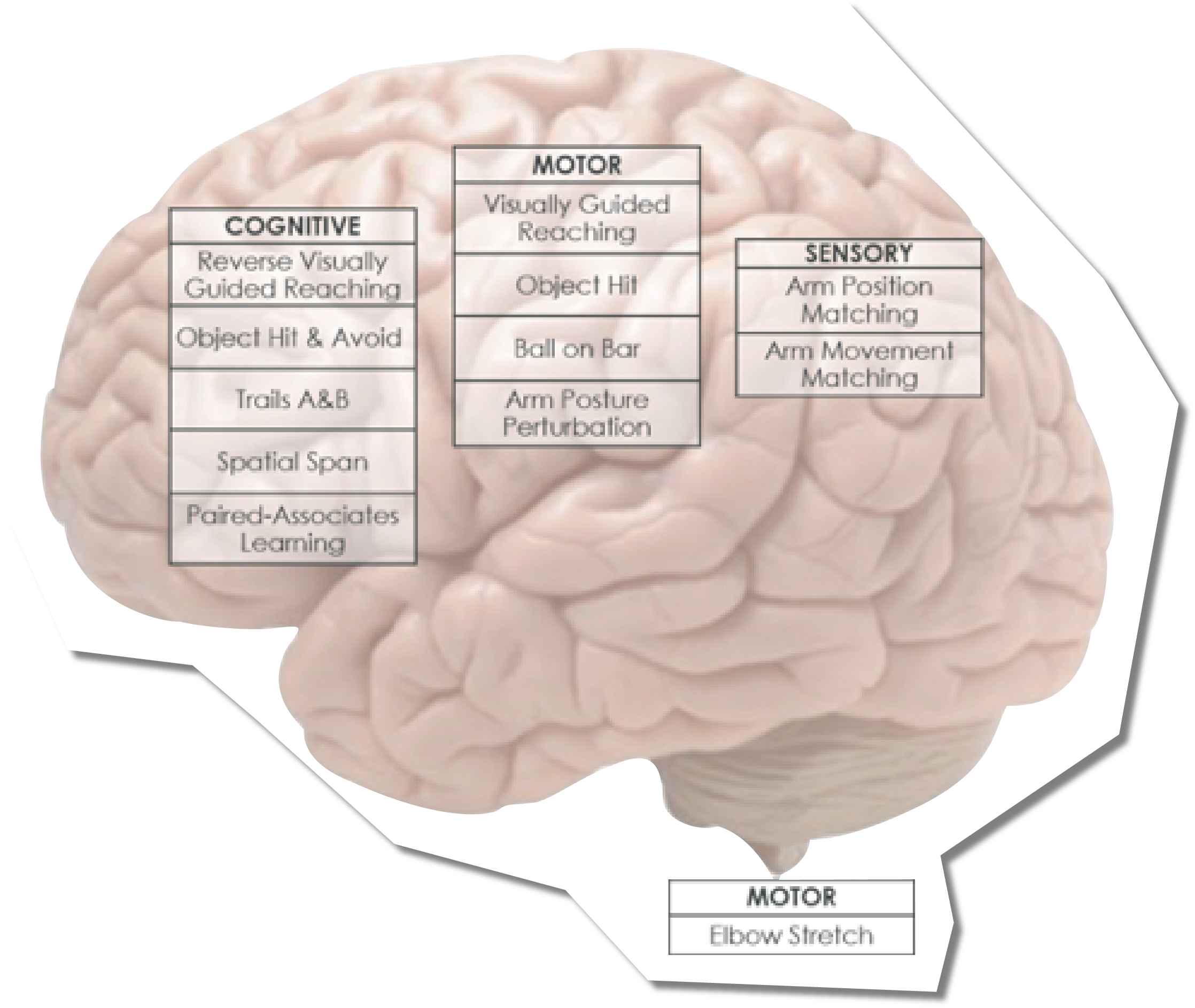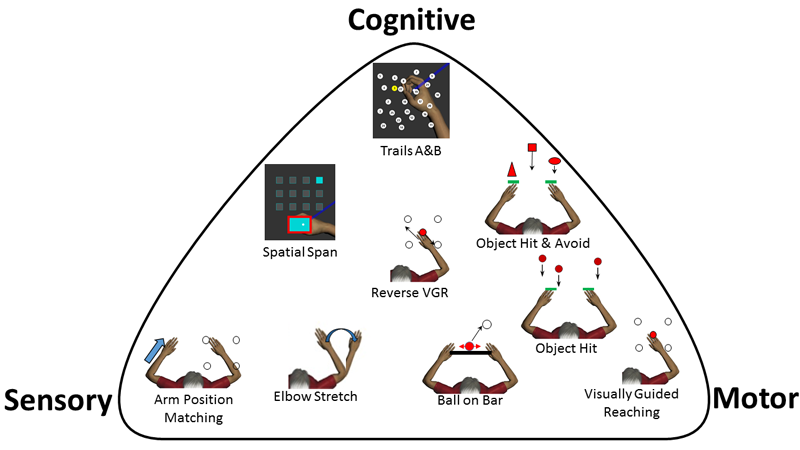Kinarm 标准测试 (Kinarm Standard Tests,KST)包括一套标准化协议,允许临床研究人员在很短的时间内对大脑功能进行广泛的评估(30-60 分钟,取决于所选择的任务和受试者损伤的严重程度)。通过这些测试,KST 能够测量和识别受试者表现微妙但具有统计意义的变化,为开发针对脑损伤或疾病的靶向疗法的研究人员提供必要的改变指标。
Kinarm 标准测试 (Kinarm Standard Tests,KST)允许临床研究人员:
区分——对被试进行个体化行为测量,以找出特异性体现被试神经缺陷的特征
选择——根据被试神经缺陷类型筛选符合研究目的特定研究对象
目标——设计新的以患者为中心的疗法,以解决患者的特定损伤或疾病
测量——收集有关受试者对疗法的反应的客观数据
提前——将对脑损伤的治疗研究从实验室转化到临床应用
Kinarm 标准测试 (Kinarm Standard Tests,KST)的复杂性差异很大,某些高度复杂的任务允许研究人员量化不同大脑回路是如何相互作用以产生有目的的行为,而一些简单的任务允许研究人员隔离特定的大脑功能,以帮助确定特定的损伤。
Kinarm 标准测试 (Kinarm Standard Tests,KST)内的每项任务都经过专门设计,只需要为患者/受试者提供非常简单的说明,并且持续时间短,同时仍能提供有见地的结果。对 KST 收集的数据进行分析,生成显示面值有效性的参数;可重复且响应迅速;提供连续的性能衡量指标;并有助于尽量减少上述地板和天花板的影响。
虽然所有的 Kinarm 标准测试 (Kinarm Standard Tests,KST)都是专门为成人开发的,但 Dexterit-E ™(Kinarm 实验室的操作和控制软件)现在也包含了一系列适合儿童的程序。针对18-85岁的成人被试的标准模型已经开发完毕。针对儿童的标准模型正在开发,并将成为 KST 未来发布的一部分。
关于每个任务参数和示例报告可以在Kinarm网站下载。所有测试均一公开发表在同行评议出版刊物上 (; ; ; ; , ; ) 。
Kinarm Standard Tests™ | |||
Test | Behavioural Task | Brain Function | Duration |
COGNITIVE | |||
Reverse Visually Guided Reaching | Subject reaches from a central target to a peripheral target where the visual feedback is reversed compared to the actual hand position. | Cognitive control of visuomotor skills Inhibitory control Attention | 3.5 min/arm |
Object Hit & Avoid | Subject hits away targets with either hand and avoids distractors. Speed and number of objects increase with time. | Rapid motor decisions Inhibitory control Spatial attention | 2.5 min |
Trails A&B | Trail A: trace a sequence of targets numbered 1 to 25; Trail B: trace alternating numeric-alpha sequence of targets 1-A-2-B etc. | Executive function: task switching | 2.5 min |
Spatial Span | Sequence of squares displayed; subject replays sequence by reaching to the appropriate squares in sequence. | Visuospatial working memory | 5.5 min |
Paired-Associates Learning* | Images shown in spatial locations then hidden. Upon presentation of an image, subject must indicate the spatial location of the hidden image. *3.9 task only | Visuospatial working memory | 5 min |
MOTOR | |||
Visually Guided Reaching | Subject reaches from a central target to a peripheral target. | Visuomotor skills Multi-joint coordination | 2 min/arm |
Object Hit | Subject hits away balls with either hand. Speed and number of balls increase with time. | Rapid visuomotor skills Spatial skills | 2.5 min |
Ball on Bar
| Subject moves a virtual ball balanced on a bar held by both hands to spatial targets. | Bimanual coordination Visuomotor skills | 3.5 min |
Arm Posture Perturbation | Subject maintains hand at target and returns to the target after an unexpected disturbance. | Goal-directed motor corrections | 2 min/arm |
Elbow Stretch | Subject relaxes; robot extends and flexes the elbow repeatedly (Exo only). | Assess presence of spasticity and high tone | 5 min/arm |
SENSORY | |||
Arm Position Matching | Robot moves one arm; the subject mirror-matches position with their other arm. | Somatosensation: position sense | 3 min/arm |
Arm Movement Matching | Robot moves one arm; the subject mirror-matches movement with their other arm. | Somatosensation: kinesthesia | 3 min/arm |





